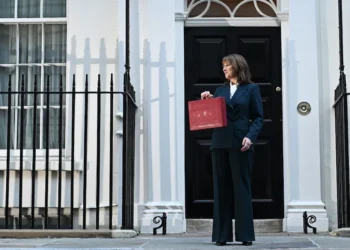A major calculation error by the Office for Budget Responsibility (OBR) has reduced Chancellor Rachel Reeves’ spending headroom by a staggering £18 billion, sparking fresh worries about her budget’s sustainability and investor reactions.
The unexpected revision has left Reeves with less flexibility to maneuver within her fiscal rules, raising questions about the feasibility of her spending plans and heightening market scrutiny.
The OBR published a critical update alongside Reeves’ first budget, acknowledging an error in its March projections for public sector net financial liabilities (PSNFL). This metric is a cornerstone of Reeves’ new fiscal policy framework, which focuses on ensuring financial responsibility while still allowing for government investment.
The updated margin, or “headroom,” now stands at £43.9 billion for the 2028-29 fiscal year, down from the original £62 billion forecast.
A footnote in the OBR’s statement confirmed the discrepancy, stating, “An error was identified in the net liabilities calculation used in the March 2024 forecast of PSNFL. The restated March PSNFL forecast and headroom calculation correct this error but otherwise is unchanged.”
The shrinking headroom figure may affect how investors view the cost of government borrowing and influence future market reactions.
Budget Headroom Narrower Than Expected
With the new error-corrected forecast, analysts believe that Reeves will now have only £15.7 billion left in the margin by the end of 2029-30. This limited financial flexibility follows her budget proposals, which included plans for £142 billion in additional borrowing to fund various government initiatives. Dan Hanson, BloombergEconomics’ chief UK economist, noted that markets had anticipated a larger buffer.
“The expectation in markets prior to the budget was that even if Reeves did borrow to invest, the changes to the debt metric would mean she would still be left with a healthy amount of headroom against her fiscal target. In the event, the headroom was wafer thin.”
Dan Hanson
According to Hanson, this narrow margin results not only from Reeves’ higher-than-expected borrowing but also from the OBR’s original error in estimating available fiscal space.
Reeves’ budget marks Labour’s first since coming to power, and while the OBR error may complicate her financial plans, Treasury Minister Darren Jones defended the government’s approach.

He emphasized the differences between Reeves’ strategy and the controversial mini-budget introduced by former Prime Minister Liz Truss last year. Jones argued that current market responses to the budget should be seen as normal rather than alarming.
“Markets always respond to budgets in the normal way,” Jones explained, emphasizing that new financial information often brings about short-term fluctuations. He pointed to the contrasting approaches of the current administration and Truss’s brief tenure as prime minister, stating, “I think we’ve all got PTSD from Liz Truss.”
Jones clarified the government’s intentions by contrasting Reeves’ approach with the decisions made under Truss.
“Under Liz Truss, as we saw, they sacked the permanent secretary, ignored the independent Office for Budget Responsibility, announced £45 billion of unfunded tax cuts, and said they were only just getting started. And then the market went mad and we all know what happened.”
Treasury Minister Darren Jones
For Reeves, the OBR’s revised calculations place her fiscal policy under the spotlight as she works to balance Labour’s investment ambitions with a commitment to financial stability.
READ ALSO: Salam Mustapha Apologizes to Gyampo, Retracts Defamatory Allegations























